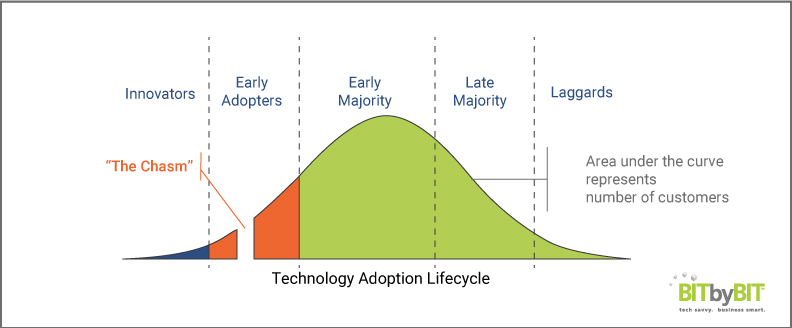All forms of technological advances, whether recent innovations, or changes that came about during the industrial revolution, experience something referred to as the “technology adoption lifecycle.” Emerging companies, processes, systems, and products are either made or broken within the technology adoption lifecycle, and Microsoft Office 365 is no exception. What many people fail to realize is that the migration to Microsoft 365 is one of the largest business migrations in history.
What is the Adoption Technology Lifecycle?
Everett Rogers, an American communication theorist and sociologist, called this phenomenon “the diffusion of innovations.” The diffusion of innovations theory explains how, why, and at what rate new ideas and technology spread. He classified the market into five main groups (from Diffusion of Innovations):
- Innovators (2.5%) – Innovators are the first individuals to adopt an innovation. They are willing to take risks, youngest in age, have the highest social class, have great financial lucidity, very social and have closest contact to scientific sources and interaction with other innovators. Risk tolerance has them adopting technologies which may ultimately fail. Financial resources help absorb these failures. (Rogers 1962 5th ed, p. 282)
- Early Adopters (13.5%) – This category of individuals is the second fastest to adopt an innovation. They have the highest degree of opinion leadership among the other adopter categories. Early adopters are typically younger in age, have a higher social status, have more financial lucidity, advanced education, and are more socially forward than late adopters. More discrete in adoption choices than innovators. Realize judicious choice of adoption will help them maintain central communication position (Rogers 1962 5th ed, p. 283).
- Early Majority (34%) – Individuals in this category adopt an innovation after a varying degree of time. This time of adoption is significantly longer than the innovators and early adopters. Early majority tend to be slower in the adoption process, have above average social status, contact with early adopters, and seldom hold positions of opinion leadership in a system (Rogers 1962 5th ed, p. 283)
- Late Majority (34%) – Individuals in this category will adopt an innovation after the average member of the society adopts it. They approach an innovation with a high degree of skepticism and only after the majority of society has adopted an innovation. Late majority are typically skeptical about an innovation, have below average social status, very little financial lucidity, and are in contact with others in late majority and early majority. Their opinion leadership is minimal.
- Laggards (16%) – Individuals in this category are the last to adopt an innovation. Unlike some of the previous categories, individuals in this category show little, to no, opinion leadership. These individuals typically have an aversion to change-agents and tend to be advanced in age. Laggards typically tend to be focused on “traditions,” likely to have lowest social status, lowest financial fluidity, be oldest of all other adopters, and in contact with only family and close friends.
Author and management consultant, Geoffrey Moore, offered a variation to Roger’s adoption lifecycle in his 1991 book, Crossing the Chasm. Moore noted that there is a chasm between the first two adopter groups (Innovators/Early Adopters) and the vertical markets (Early Majority/Late Majority). He determined that if a company is able to successfully navigate the leap between these segments, then a product would become the standard.
Where is Microsoft Office 365 on the Technology Adoption Curve?
Almost seven years ago, Microsoft released their game-changing cloud software solution: Microsoft Office 365. At the time of the release, the technology landscape was tilting in favor of mobile devices and cloud services, and Microsoft also shifted their strategy to a cloud focus.
Office 365’s cloud technology swiftly gained momentum across industries in both the SMB and enterprise markets.
Microsoft’s new cloud service allows for improved efficiencies and added securities. It did away with the need to directly download software to a user’s computer. Instead, technical teams could deploy software to an entire organization with a push of a button. It was a game-changing move in the marketplace, and under Satya Nadella’s stewardship, Microsoft is poised to increase its overall market share of cloud-based applications while maintaining its leadership in business applications.
During Microsoft’s October 2017 earnings report, they announced that Office 365’s monthly active commercial users increased by more than 20 million users just since April of last year. Microsoft also reported for the first time that subscription revenue surpassed non-subscription licensing. Nadella’s vision to remake Microsoft into a subscription company where customers rent rather than buy software is being realized.
With Office 365 gaining a foothold as the most popular enterprise cloud service, this leads us to wonder, where is Office 365 on the technology adoption lifecycle in 2018?
Technology will always move left to right on the adoption curve, never backward. Based on the following, Office 365 has successfully crossed the chasm and is in the early majority segment of Roger’s bell curve:
- According to Skyhigh’s Cloud Adoption Risk Report of Q4 2016, Office 365 had five applications from the top 20 cloud services: OneDrive, Exchange Online, SharePoint Online, Yammer, and Skype for Business.
- As of 2016, enterprise companies with at least 100 Office 365 users increased from 87.3% to 91.4% and usage rates increased by 320% for employees using at least one Office 365 application.
- Cloud technology, such as Google G Suites, has been around for 10+ years.
- Rare is the request where customers ask for on premise technology options. The question has evolved to, which cloud service?
- Skyhigh’s 2016 Office 365 Adoption & Risk Report states that between 2014-2016, “Office 365 eclipsed all other cloud providers to emerge as the most widely used enterprise cloud service by user count.”
Office 365 offers applications suitable for SMB as well as enterprise, allowing for more coverage in the marketplace. As popularity of this solution continues to gain momentum and charge up the early majority stage of the technology adoption lifecycle, cloud computing services as a whole will grow in popularity. When cloud services for enterprise become standard, Office 365 is positioned to be on the frontline. It will lead in offering services to the late majority while continuing to evolve to keep the interest of those in the earlier stages of the technology adoption lifecycle.
Sources:
- https://www.geekwire.com/2016/five-years-launch-microsofts-office-365-popular-enterprise-cloud-service/
- https://www.skyhighnetworks.com/cloud-security-blog/7-charts-reveal-the-meteoric-rise-of-office-365/
- https://www.skyhighnetworks.com/cloud-report/
- https://www.zdnet.com/article/microsoft-office-365-now-has-120-million-business-users/





